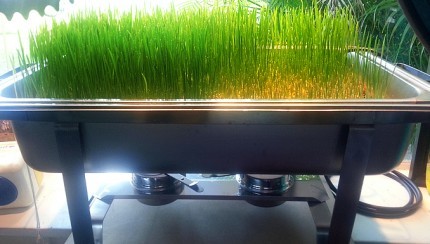Co-authored with Emily Rodgers
For many of us, we fly through our jam-packed days with hardly any time for breaks - let alone healthy meal planning. So, it's no wonder fast food becomes an option when it otherwise wouldn't be. A considerable amount of planning is required in order to feed ourselves healthy food regularly. Thankfully, technology is providing us with a new kind of fast food in the form of growing your own - and the options are endless.
Gardening technology has brought us automated soilless growing methods such as hydroponics, aquaponics, and aeroponics. Systems like the Tower Garden or edible wall units offer you a way to grow your food, in your own home, at anytime of year. There are even indoor gardening services that will set systems up for you in your home or office.
An increasing number of individuals and families are insisting on knowing where their food is coming from. Several years ago, a lack of awareness and information had many of us buying into the stories about how our food was being produced and where is was coming from. Now, there is a new kind of movement: the right to know how your food is being produced.
Fast Food Grown in Indoor Urban Gardens
1. Indoor Garden Plants
There are several plants that grow indoors using hydroponics. Growing these plants gives you the ability to eat well by harvesting your own lettuce, tomatoes, cucumbers, and even your kale, all year.
2. Microgreens
Growing microgreens in your kitchen can be fun, decorative, good for your air quality and rewarding. Not to mention it's a great way to improve your health. Growing your own microgreens gives you instant access to fast, healthy food choices.
It's easy to grow your own microgreens using grow trays or all-in-one start up systems. You can even try growing them vertically on your wall!
3. Herbs
Herbs can be grown anywhere and take up very little space. Consumer demand for herb gardens is so high that there are now several self-contained units that make it easy and mess free. Once you've started growing these herbs hydroponically, it will only take 10-20 days to regenerate the plants.
Did you know that many restaurants grow their own microgreens and herbs or have them sourced locally?
Food Grows Faster In Controlled Environments
Fast food seems to still be a concern for many individuals as our days get busier and busier. Having healthy fast food at our fingertips is needed for our fast-paced lifestyles. Soil-less growing provides solutions for controlling your options, even when you are rushed and don't have much time. In fact, soil-less agriculture using hydroponic technology is making the goal of healthy fast food choices a reality.
Hydroponic technology has developed systems that are controlled to optimize growing times, reduce pests, and remain impervious to weather conditions. There are even automated systems available which can be controlled from your smartphone! A hydroponic system makes a lot easier to maintain an ideal gardening environment.
Urban Agriculture Feeds High-Paced Cities
There are certainly benefits to both traditional agriculture and urban agriculture. As a matter of fact we need both. Indoor gardening in the city makes our food more accessible, while cutting down on transportation costs and pollution. Many of the harmful effects that agriculture has on the environment is mitigated by hydroponically-grown produce. This is because crops grow faster and deliver higher yields than through soil.
Hydroponics has the potential to produce maximum yields. For example, cayenne chilies grown hydroponically can be ready in 55 days, while when grown in soil it can take 90 days. It has been proven that urban agriculture through hydroponic methods results in growth rates of up to 20-30% faster with up to a 50% larger crops*.
*Results may vary depending on controlled conditions.
